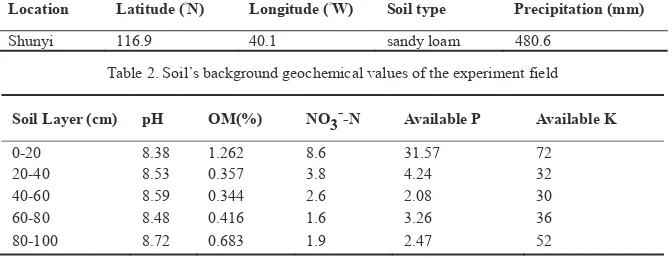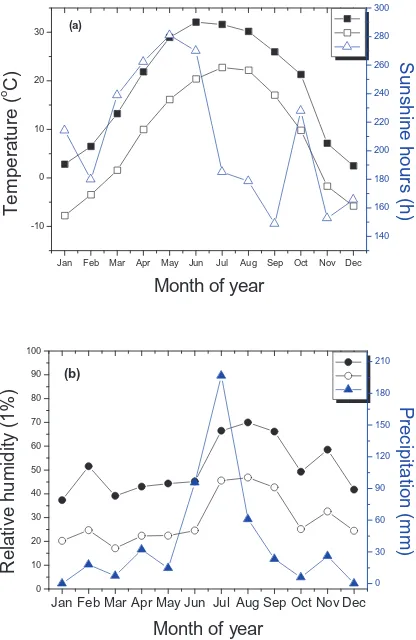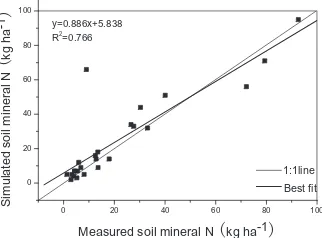Physics Procedia 25 ( 2012 ) 2014 – 2018
1875-3892 © 2012 Published by Elsevier B.V. Selection and/or peer-review under responsibility of Garry Lee doi: 10.1016/j.phpro.2012.03.343
2012 International Conference on Solid State Devices and Materials Science
Applicability of an Agro-hydrological Model (SMCR_N) in
Simulating the Yield and Nitrate Dynamics of Eggplant in
North China Plain
Yiwei Dong
1,3, Chunying Xu
2, Dazhou Zhu
3, Qiaozhen Li
1, Fuli Fang
1, Yuzhong
Li
1,*1. Institute of Environment and Sustainable Development in Agriculture, the Chinese Academy of Agricultural Sciences, Beijing, P. R. China
2.Key Laboratory of Agro-Environment & Climate Change, Ministry of Agriculture, Beijing, P. R.China 3. National Research Center of Intelligent Equipment for Agriculture, Beijing, P. R. China
Abstract
SMCR_N is a recently developed sophisticated model which simulates crop response to nitrogen fertilizer for a wide
range of crops, and the associated leaching of nitrate from arable soils. The objective of this study was to investigate
the possibility of using SMCR_N model as a research tool to investigate interactions between the amount and timing
of N application and effects on vegetable production and environmental impact. In this paper, we used data from 16
field plot experiments to carry out the model calibration and found out that the simulated values of crop dry weight
were strongly correlated with the measured values throughout growth in all the experiments with a R
2of 0.9248.
Then we choose the field plot 1 to carry out the model validation. The simulated soil mineral N concentration was
less satisfactory, although statistically the simulated values of soil mineral N concentration were still correlated fairly
well with the measured values (R
2= 0.766). This indicate that the model has the potential to optimize N use and
assess the impact of N leaching in eggplant production under the temperate continental monsoon climate of the North
China Plain.
© 2011 Published by Elsevier Ltd. Selection and/or peer-review under responsibility of [name organizer]
Keywords:model, eggplant, yield, soil mineral N, North China Plain
1.
Introduction
Agro-hydrological models have proved to be useful tools in optimizing irrigation scheduling and
fertilizer application, and in assessing the impact of different farming practices on the environment.
Numerous models have been reported for these purposes in the literature in the last few decades [9,1,15,5,
8,3,11,10,13,14,12]
Many of agro-hydrological models are devoted to assessing the effects of nitrogen (N) fertilizer on crop
© 2012 Published by Elsevier B.V. Selection and/or peer-review under responsibility of Garry Lee
Open access under CC BY-NC-ND license.
growth and N leaching for various crop species[4]. The most prominent models that cover a range of
crops are the EPIC models[15] and the DSSAT models[8]. Although the EPIC and DSSAT models have
proved useful in both basic and applied studies of the effects of climate and management on growth and
the environment, the models are generally crop specific, and require parameter values which are difficult
to determine for a given crop.
SMCR_N model, which is based on a version of N_ABLE[7], has been developed for crop N response
and N leaching in arable soils[17]. The model covers a wide range of crops, which makes it a good
candidate for forecasting both optimum N inputs and the environmental consequences of crop production.
The aim of the study was to validate the SMCR-N model against the data from the Shunyi Science
Base to access the ability of the model in predicting N dynamic and crop yield in eggplant production
under the temperate continental monsoon climate of the North China Plain.
2.
Materials and metheds
2.1 SMCR_N model
The inputs for running the SMCR_N model include site characteristics, weather data, soil properties,
fertilization and irrigation and cropping parameters together with the initial conditions[17].
2.2 Experimental data
Measured data sets from
¿
eld experiments from Shunyi District, Beijing City, China were used for model
validation. A site description is given in Table 1. The SMCR_N model was tested using
¿
eld
measurements from 16 treatments at one location (Unpublished data).
Table 1. Experimental sites used for simulation-observation comparisons
Location Latitude (ƕN) Longitude (ƕW) Soil type Precipitation (mm)
Shunyi 116.9 40.1 sandy loam 480.6
Table 2. Soil’s background geochemical values of the experiment field
Soil Layer (cm) pH OM(%) NO3--N Available P Available K
0-20 8.38 1.262 8.6 31.57 72
20-40 8.53 0.357 3.8 4.24 32
40-60 8.59 0.344 2.6 2.08 30
60-80 8.48 0.416 1.6 3.26 36
80-100 8.72 0.683 1.9 2.47 52
2.3 Weather data
Jan Feb Mar Apr May Jun Jul Aug Sep Oct Nov Dec -10
0 10 20 30
Month of year
Temper
at
ur
e (
o
C)
140 160 180 200 220 240 260 280 300
Sun
sh
ine
ho
ur
s (h
)
(a)
Jan Feb Mar Apr May Jun Jul Aug Sep Oct Nov Dec 0
10 20 30 40 50 60 70 80 90 100
Month of year
Relat
ive humidit
y (1
%)
0 30 60 90 120 150 180 210
Precipit
at
io
n (mm)
(b)
Fig. 1. Average monthly sunshine hours (ǻ), maximum (Ŷ) and minimum (Ƒ) temperature(a), and Precipitation (Ÿ), average humidity (Ɣ) and minimum humidity (ż)(b) are based on weather data of Shunyi (2009).
3.
Results and discussion
35 40 45 50 55 60 65 35
40 45 50 55 60 65
Simulat
ed dry weigh
t
t ha
-1
Measured dry weightt ha-1
1:1line Best fit y=1.008x-0.503
R2=0.9248
Fig. 2. Comparison of dry matter of the selected 16 field plots between measurement and simulation
The result of simulating soil mineral N concentration was less satisfactory (Fig. 3), although
statistically the simulated values of soil mineral N concentration were still correlated fairly well with the
measured values (R
2= 0.766). This indicate that the model has the potential to optimize N use in eggplant
production under the temperate continental monsoon climate of the North China Plain.
0 20 40 60 80 100
0 20 40 60 80 100
Simulated s
o
il mineral N
kg ha
-1
Measured soil mineral N
kg ha-1 y=0.886x+5.838R2=0.766
1:1line Best fit
Fig. 3. Comparison of soil mineral N of field plot 1 between measurement and simulation
4.
Conclusion
From this comprehensive set of model–observation comparisons, it is concluded that the SMCR-N
model is capable of reproducing the measured data. The simulated results agree well with the measured
values, indicating that the model has the potential to optimize water and N use and assess the impact of N
leaching from different management strategies in eggplant production under the temperate continental
monsoon climate of the North China Plain. The SMCR-N model can thus be used as a research tool to
investigate interactions between the amount and timing of N application and effects on vegetable
production and environmental impact.
5.
Acknowledgements
References
[1] Bergstrom L., Johnsson H., Tortensson G., 1991. Simulated nitrogen dynamics using the SOILN model. Fertilizer Research 27, 181–188.
[2] Boone A., Wetzel P.J., 1996. Issues related to low resolution modeling of soil moisture: Experience with the PLACE model. Global and Planetary Change 13, 161-181.
[3] Brisson N., Gary C., Justes E., Roche D., Zimmer D., Sierra J., Bertuzzi P., Burger P., Bussière F., Cabidoche Y.M., Cellier P., Debaeke P., Gaudillère J.P., Hénault C., Maraux F., Seguin B., Sinoquet H., 2003. An overview of the crop model STICS. European Journal of Agronomy 18, 309-332.
[4] Cannavo P., Recous S., Parnaudeau V., Reau R., 2008. Modelling N dynamics to assess environmental impacts of cropped soils. Advances in Agronomy 97: 131-174.
[5] Diekkruger B., Sondgerath D., Kersebaum C.K., McVoy C.W., 1995. Validity of agroecosystem models: a comparison of results of different models applied to the same data set. Ecological Modelling 81, 3–29.
[6] Gandolfi C, Facchi A., Maggi. D., 2006. Comparison of 1D models of water flow in unsaturated soils. Environmental Modelling & Software 21: 1759-1764.
[7] Greenwood D.J., 2001. Modelling N-response of field vegetable crops grown under diverse conditions with N_ABLE: A review. Journal of Plant Nutrition 24, 1799-1815.
[8] Hoogenboom G., Wilkens P.W., Tsuji G.Y. (Eds), 1999. Decision support system for agrotechnology transfer (DSSAT) version 3, volume 4. Honolulu HI: University of Hawaii.
[9] Johnsson H., Bergstrom L., Jansson P.-E., Paustian K., 1987. Simulation nitrogen dynamics and losses in a layered agricultural soil, Agricultural Ecosystems and Environment 18, 333-356.
[10] Jones J.W., Hoogenboom G., Porter C.H., Boote K.J., Batchelor W.D., Hunt L.A., Wilkens P.W., Singh W., Gijsman A.J., Ritchie J.T., 2003. The DSSAT cropping system model. European Journal of Agronomy 18, 235-265.
[11] Keating B.A., Carberry P.S., Hammer G.L., Probert M.E., Robertson M.J., Holzworth D., Huth N.I., Hargreaves J.N.G., Meinke H., Hochman Z., McLean G., Verburg K., Snow V., Dimes J.P., Silburn M., Wang E., Brown S., Bristow K.L., Asseng S., Chapman S., McCown R.L., Freebairn D.M., Smith C.J., 2003. An overview of APSIM, a model designed for farming systems simulation. European Journal of Agronomy 18, 235-266.
[12] Liang X.Q., Chen Y.X., Li H., Tian G.M., Ni W.Z., He M.M., Zhang Z.J., 2007. Modeling transport and fate of nitrogen from urea applied to a near-trench paddy field. Environmental Pollution 150, 313-320.
[13] Stöckle C.O., Donatelli M., Nelson R., 2003. CropSyst, a cropping systems simulation model. European Journal of Agronomy 18, 289-308.
[14] Van Ittersum M.K., Leffelaar P.A., van Keulen H., Kropff M.J., Bastiaans L., Goudriaan J., 2003. On approaches and applications of the Wageningen crop models. European Journal of Agronomy 18, 201-234.
[15] Williams J.R., Jones C.A., Dyke P.T., 1993. The Epic model. in: Sharpley A.N., Williams J.R. (Eds.), Epic–Erosion Productivity Impact Calculator. 1. Model documentation. U S Department of Agriculture Technical Bulletin No 1768. USDA: Washington DC. 92 pp.
[16] Yang D., Zhang T., Zhang K., Greenwood D.J., Hammond J., White P.J., 2009. An easily implemented agro-hydrological procedure with dynamic root simulation for water transfer in the crop-soil system: validation and application. Journal of Hydrology 370, 177-190.


